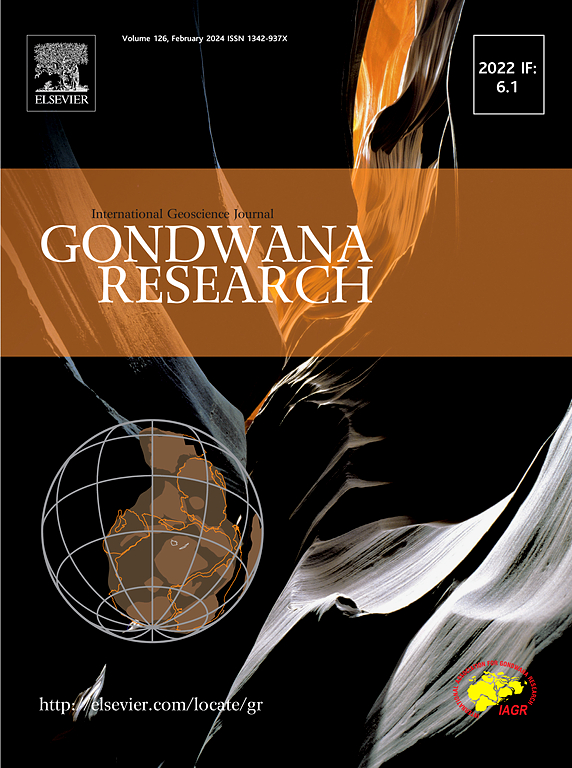The Karharbari Formation (late Sakmarian–early Artinskian), India: A biostratigraphic, palaeoclimatic, and vegetational framework for Cisuralian Gondwana correlation
IF 7.2
1区 地球科学
Q1 GEOSCIENCES, MULTIDISCIPLINARY
引用次数: 0
Abstract
The Karharbari Formation of Peninsular India, long considered a transitional unit between the Talchir and Barakar formations, is re-evaluated here as a distinct palaeoecological and stratigraphic interval of Late Sakmarian to Early Artinskian age. Integrating megafloral, palynological, petrographic, coal, and lithostratigraphic data, this review synthesizes records from multiple Lower Gondwana coalfields to clarify the formation’s spatial extent, floral composition, and environmental character. Biostratigraphically anchored by the Crucisaccites monoletus Assemblage Zone, the Karharbari strata exhibit strong regional coherence across basins, supported by floral and faunal correlatives in peri-Gondwanan and southern high-latitude Gondwanan settings, including Australia, South Africa, and South America. The vegetation reflects two interrelated ecological domains: a terrestrial forest system dominated by Gangamopteris, Noeggerathiopsis, and early Glossopteris: and a marshy wetland system comprising Schizoneura, Gondwanidium, and lycopsid groundcover. Conceptual models of floral transition, coal petrography, and climatic trajectory illustrate the formation’s role as a post-glacial recovery phase and precursor to widespread Glossopteris-dominated swamps. Collectively, the Karharbari Formation emerges as a regionally mappable, biostratigraphically distinct, and ecologically transitional unit within the Lower Gondwana, offering a valuable reference point for Cisuralian correlations across Gondwana continents.

印度Karharbari组(sakmarian晚期- Artinskian早期):古古气候和植被格架
印度半岛的Karharbari组,长期以来被认为是Talchir组和Barakar组之间的过渡单元,在这里被重新评估为Sakmarian晚期到Artinskian早期的一个独特的古生态和地层间隔。本文综合了大花、孢粉、岩石、煤和岩石地层等资料,综合了多个下冈瓦纳煤田的记录,阐明了下冈瓦纳煤田的空间范围、花组成和环境特征。在生物地层学上,Karharbari地层以Crucisaccites monoletus组合带为锚定,在盆地之间表现出很强的区域一致性,并在冈瓦南周边和南部高纬度冈瓦南环境(包括澳大利亚、南非和南美洲)中得到植物和动物相关物的支持。植被反映了两个相互关联的生态域:以Gangamopteris、Noeggerathiopsis和早期gloopteris为主的陆生森林系统;以及一个由裂藤属、冈瓦尼属和石松属地被植物组成的沼泽湿地系统。植物转变、煤岩学和气候轨迹的概念模型说明了该地层作为冰期后恢复阶段的作用,以及广泛的舌蕨为主的沼泽的前兆。总的来说,Karharbari组是下冈瓦纳的一个区域性的、生物地层学上独特的、生态上过渡的单元,为冈瓦纳大陆上的cisurian相关性提供了一个有价值的参考点。
本文章由计算机程序翻译,如有差异,请以英文原文为准。
求助全文
约1分钟内获得全文
求助全文
来源期刊

Gondwana Research
地学-地球科学综合
CiteScore
12.90
自引率
6.60%
发文量
298
审稿时长
65 days
期刊介绍:
Gondwana Research (GR) is an International Journal aimed to promote high quality research publications on all topics related to solid Earth, particularly with reference to the origin and evolution of continents, continental assemblies and their resources. GR is an "all earth science" journal with no restrictions on geological time, terrane or theme and covers a wide spectrum of topics in geosciences such as geology, geomorphology, palaeontology, structure, petrology, geochemistry, stable isotopes, geochronology, economic geology, exploration geology, engineering geology, geophysics, and environmental geology among other themes, and provides an appropriate forum to integrate studies from different disciplines and different terrains. In addition to regular articles and thematic issues, the journal invites high profile state-of-the-art reviews on thrust area topics for its column, ''GR FOCUS''. Focus articles include short biographies and photographs of the authors. Short articles (within ten printed pages) for rapid publication reporting important discoveries or innovative models of global interest will be considered under the category ''GR LETTERS''.
 求助内容:
求助内容: 应助结果提醒方式:
应助结果提醒方式:


